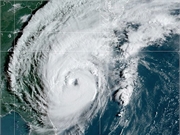WEDNESDAY, Aug. 19, 2020 (HealthDay News) — A hurricane is bearing down on your coastal community, bringing with it deadly storm surge flooding and airborne debris propelled by high winds.
But this year there’s another killer lurking about — the invisible menace posed by the COVID-19 coronavirus.
Public health and emergency management experts are sounding the alarm that the twin risks of the annual hurricane season and the COVID-19 pandemic are likely to overlap in the coming weeks and months.
“The ways to mitigate both risks are in many respects in contradiction. We mitigate COVID by keeping people apart, and you mitigate the risk of hurricanes by moving people typically into close, confined spaces, and that makes things quite difficult,” said Dr. Sandro Galea, dean of the Boston University School of Public Health.
“The worry is that we will be unsuccessful in dealing with both of them,” Galea continued. “Trying to move people away from hurricanes we will make COVID worse, or being worried about COVID means that people won’t move away from hurricanes.”
Hurricane season typically runs from June to November, with most storms hitting between August and October, according to the National Weather Service.
The season approaches even as COVID-19 runs rampant in many Southern states. U.S. COVID cases increased by 3.7 times between states emerging from lockdown in May and the landfall of Hurricane Hanna on July 24, according to an opinion piece coauthored by Galea in the Aug. 12 Journal of the American Medical Association.
“We’ve had an escalation of COVID in the hurricane states, those states bordering the Gulf of Mexico and the Atlantic,” said co-author James Shultz, director of the Center for Disaster and Extreme Event Preparedness at the University of Miami’s Miller School of Medicine. “COVID has erupted in the hurricane coast states, and we now have an underlying, very, very substantial burden of COVID infection in our communities.”
A lesson from other countries
The United States already has a cautionary tale of what can happen if COVID-19 isn’t accounted for in hurricane planning, from earlier this year in South Asia, the experts noted in their article.
A cyclone hit the Bay of Bengal in May, prompting the evacuation of more than 2.2 million people in Bangladesh and another 4.3 million in India while both nations were in COVID-19 lockdowns, the experts say.
People were sent to 15,000 shelters across the region, many more than ever before to promote social distancing between evacuees. Nonetheless, storm-affected regions wound up with a spike in new COVID-19 cases.
People absolutely need to get out of the way of an oncoming hurricane, Shultz said.
“The risk of not evacuating is that you will be harmed, injured, hurt by an encounter with hurricane hazards,” Shultz said. “Our first concern is that, given the fact there’s a considerable burden of COVID, will people evacuate? Will people take action to protect themselves?”
But extra caution must also be taken to protect evacuees from COVID infection, Shultz and Galea said.
“When you do evacuate and shelter with others, do realize your risk for COVID is a real one and you have to take precautions you haven’t taken when sheltering for past hurricanes,” Shultz said.
Emergency managers are adding new shelters to promote social distancing, and configuring them in ways to keep people farther apart, Galea and Shultz said. For example, classrooms could be used to house evacuees in schools while keeping them better separated, as opposed to giving everyone a cot in the gymnasium.
Shelters also need to be well-stocked with masks, gloves and other protective equipment, as well as disinfectants, sanitizers and soap, Galea said.
Risks of staying with friends and family
However, shelter preparation is only part of the problem. Many folks who consider themselves seasoned hurricane veterans don’t bother with shelters, and they need to be aware of their COVID risk as well, Shultz said.
“A very large number of people don’t shelter in community shelters. For season after season, they’ve had a designated family member or friend that has a really well-hardened house or structure they can shelter in. They come together and they spend the hurricanes together in groups of people,” Shultz said.
“I don’t think there’s been sufficient education right now about the fact that these may be your family members, they may be your friends, but actually that’s where a great deal of the transmission of COVID is taking place, in households,” Shultz said. “Even though you come together with people you know, trust, love, care about, they in the era of COVID might actually pose a hazard to each other.”
Galea and Shultz offer three steps that could help keep people safe from both hurricanes and COVID:
- Reestablishing the COVID-19 prevention lifestyle, including masks, hand-washing and social distancing.
- Improving communications to promote evacuation as well as protecting oneself against COVID.
- Take lessons from each storm to improve safe evacuation plans and messages.
In the meantime, Shultz is hopeful that this is the one and only year where these twin risks will overlap.
“Maybe next year we’ll have a vaccine,” Shultz said. “It might be this is the year where we have this double-threat scenario, and perhaps in future years it will be less of an issue. But it certainly is this year.”
More information
The U.S. Centers for Disease Control and Prevention has more about hurricanes and COVID-19.
Copyright © 2025 HealthDay. All rights reserved.

